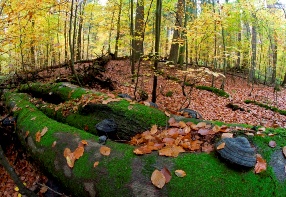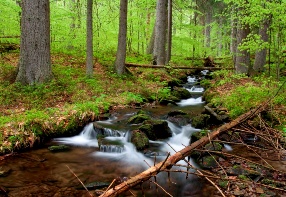Boubín virgin forest
Boubín virgin forest is the best renowned protected area in the Czech Republic. At the same time, it is one of the oldest forest reserves in Europe. The natural development of the forest vegetation in this part of Boubín forest, for centuries almost untouched by humans, was the reason for its protection. Indeed, Boubín is not so distant from civilization as it is also part of the Central European cultural landscape. The history of the Boubín Forest Reserve is associated with the cultural history of this region due to its position near the borders of three countries: the Czech Republic, Austria and Germany.
Smugglers' trails and forestry
For human beings (with the exception of hermits, gamekeepers and similar individuals), forests have always represented uninhabitable places and the human imagination has often associated them with ghosts, spirits, wild animals and things that terrify people. It was easy to lose your way or your life in the woods and people therefore went there only when necessary, to earn their living or to get money. Two smugglers' trails used to criss-cross Boubín forest in the past and almost everything was smuggled along them; salt, gunpowder, cattle, grain and corn, and also the popular drug of the Šumava region, called Brizil. It was based on tobacco, then pork lard, dried prunes and pepper were added and the mixture was enjoyed as snuff. Glass production also thrived in the Šumava and the glass-works could be compared to fire dragons in their consumption of wood. But although the glass-works in Kubova Huť was only a few kilometres from the forest, it only used wood from its immediate vicinity, and soon went bankrupt, thus leaving the forest alone. It was difficult to access the Boubín forest to exploit its timber. And even construction of the nearby Schwarzenberg canal, which transported timber to Vienna and Prague, did not endanger the forest, leaving it intact.
Its final rescue from human activities was a deed of the verderor Josef John (1802-1871), whose intentions came to the attention of the then owner of the forest, the Count John of Schwarzenberg. In 1858 the count therefore decided that: 'for all times, the remaining parts of the original forest are declared virgin forest and no timber exploiting or works shall be carried out there at all, and the forest shall be left as is.' The forest originally stretched over an area of 144 hectares; however a protective zone around the forest itself was later enlarged. It was declared the Boubín Virgin Forest National Nature Reserve in 1933 and the area was enlarged to unbelievable 666 hectares in 1958. Some trees in the forest are 400 years old, which means that they sprouted before the Thirty Years’ War and were already 10 metres high when Komenský was writing his books and Rembrand was painting his pictures. The king of spruce, which fell down on 4th December 1970, lived for more than 440 years and with its height of 57 metres was just a bit shorter than Petřín lookout tower in Prague (60 metres). Another speciality of Boubín virgin forest are the so-called stilt roots.


